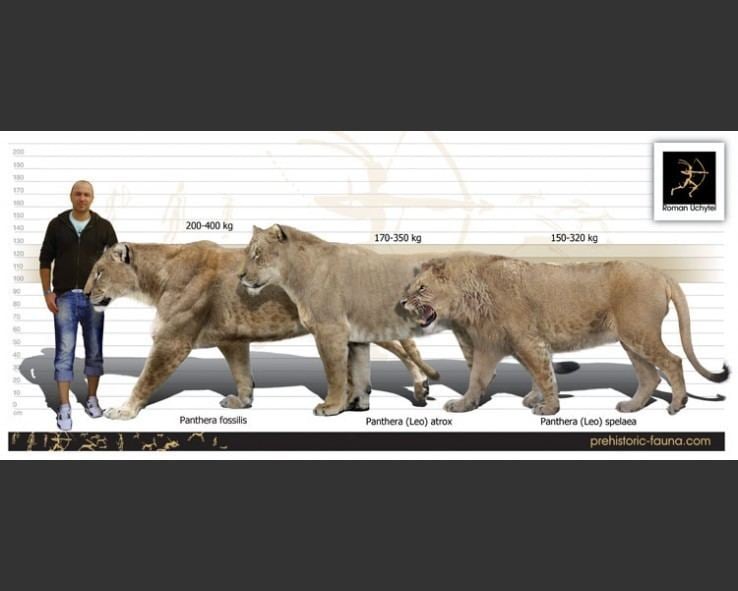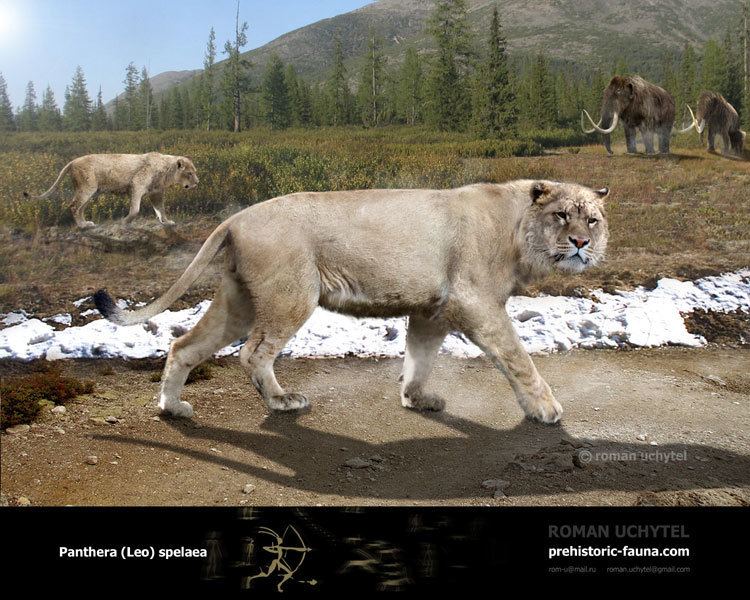Kingdom Animalia Order Carnivora Genus Panthera Higher classification Lion | Phylum Chordata Family Felidae Scientific name Panthera leo spelaea Rank Subspecies | |
Similar Lion, American lion, Cave bear, Panthera leo fossilis, Woolly rhinoceros | ||
Panthera leo spelaea better version
Panthera leo spelaea commonly known as the European or Eurasian cave lion, is an extinct subspecies of lion. It is known from fossils and many examples of prehistoric art.
Contents
- Panthera leo spelaea better version
- Taxonomy
- Evolution
- Description
- Palaeobiology
- Distribution and habitat
- References

Taxonomy

P. leo spelaea has been proposed as a separate species Panthera spelaea. One authority considered the cave lion to be more closely related to the tiger based on a comparison of skull shapes, which would have resulted in the formal name Panthera tigris spelaea. Past DNA studies indicated that among extant felids, the cave lion was most closely related to the modern lion and that it formed a single population with the Beringian cave lion, which has sometimes been considered a distinct form. Therefore, the cave lion ranged from Europe to Alaska over the Bering land bridge until the late Pleistocene. A recent DNA study indicates that it is a separate species which diverged from a common ancestor shared with the lion 1.9 million years ago

Analysis of skulls and mandibles of a lion that inhabited Yakutia (Russia), Alaska (United States), and the Yukon Territory (Canada) during the Pleistocene epoch suggested that it was a new subspecies different from the other prehistoric lions, Panthera leo vereshchagini, known as the East Siberian- or Beringian cave lion. It differed from Panthera leo spelaea by its larger size and from the American lion (Panthera leo atrox) by its smaller size and by skull proportions. However, recent genetic research, using ancient DNA from Beringian lions found no evidence for separating Panthera leo vereshchagini from the European cave lion; indeed, DNA signatures from lions from Europe and Alaska were indistinguishable, suggesting one large panmictic population.

In October 2015 two frozen cave lion cubs, estimated to be at least 10,000 years old, were discovered in Yakutia, Siberia in permafrost. Research on the specimens, named Uyan and Dina, indicated the cubs were likely barely a week old at the time of their deaths, as their baby teeth had not fully erupted. Further evidence shows the cubs were, like modern lions, hidden at a den site until they were old enough to join the pride. Researchers think that the cubs were trapped and killed by a landslide, and that without air, the cubs were preserved in such good condition. A second expedition to the site where the cubs were found is planned for 2016, in hopes of finding either the remains of a third cub or possibly the cubs' mother.
Evolution

P. leo spelaea evolved from the earlier Panthera leo fossilis, which first appeared in Europe about 700,000 years ago. Genetic evidence indicates this lineage was isolated from extant lions after its dispersal to Europe. P. l. spelaea lived from 370,000 to 10,000 years ago, during the Pleistocene epoch. Apparently, it became extinct about 12,400 14
C years ago, as the Würm glaciation receded.
Mitochondrial DNA sequence data from fossil remains show the American lion (P. l. atrox) represents a sister lineage to P. l. spelaea, and likely arose when an early P. l. spelaea population became isolated south of the North American continental ice sheet about 0.34 Mya. The following cladogram shows the genetic relationship between P. spelaea and other pantherines according to Barnett et al. (2016), besides Linnaeus (1758):
Description
This subspecies was one of the largest lions. The skeleton of an adult male, which was found in 1985 near Siegsdorf (Germany), had a shoulder height of around 1.2 m (3.9 ft) and a head-body length of 2.1 m (6.9 ft) without the tail. This is similar to the size of a very large modern lion. A large specimen is estimated to weigh 317-362 kg (700-800 lb). The size of this male has been exceeded by other specimens of this subspecies. Therefore, this cat may have been over 10% bigger than modern lions and smaller than the earlier cave lion subspecies Panthera leo fossilis or the relatively larger American lion (Panthera leo atrox). The cave lion is known from Paleolithic cave paintings, ivory carvings, and clay figurines. These representations indicate cave lions had rounded, protruding ears, tufted tails, possibly faint tiger-like stripes, and at least some had a "ruff" or primitive mane around their necks, possibly indicating males. Other archaeological artifacts indicate they were featured in Paleolithic religious rituals.
In 2008, a well-preserved cave lion specimen was unearthed near the Maly Anyuy River in Chukotka, Russia, which still retained some clumps of hair. A 2016 study identified the hair on the basis of DNA as being cave lion hair, and comparison to the hair of an African lion revealed that cave lion hair was similar in color to that of modern lions, though slightly lighter. In addition to slightly different coloration, cave lions had a very thick and dense undercoat comprising closed and compressed yellowish-to-white wavy downy hair with a smaller mass of darker coloured guard hairs, as an adaptation to the ice age climate.
Palaeobiology
These active carnivores probably preyed upon the large herbivorous animals of their time, including horses, deer, reindeer, bison and even injured old or young mammoths, which would have been killed by a powerful bite from the sharp teeth. Some paintings of them in caves show several hunting together, which suggests the hunting strategy of contemporary lionesses. Isotopic analyses of bone collagen samples extracted from fossils suggest reindeer and cave bear cubs were prominent in the diets of northwestern European cave lions. There was a suggestion of a shift in dietary preferences subsequent to the disappearance of the cave hyena. The last cave lions seem to have focused on reindeer, up to the brink of local extinction or extirpation of both species.
Distribution and habitat
P. leo spelaea populations were widespread in parts of Europe, Asia, and northwestern North America, from Great Britain, Germany, and Spain all the way across the Bering Strait to the Yukon Territory, and from Siberia to Turkistan. Panthera youngi reached to the Japanese Archipelago.
P. leo spelaea received its vernacular names because large quantities of its remains have been found in caves. It had a wide habitat tolerance, but probably preferred conifer forests and grasslands, where medium-sized to large herbivores occurred. Fossil footprints of lions, which were found together with those of reindeer, demonstrate the lions once occurred even in subpolar climates. The presence of fully articulated adult cave lion skeletons, deep in cave bear dens, indicates these lions may have occasionally entered dens to prey on hibernating cave bears, with some dying in the attempt.
